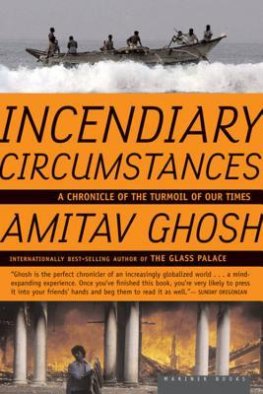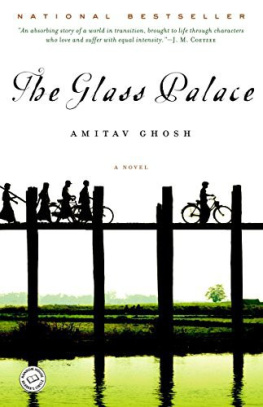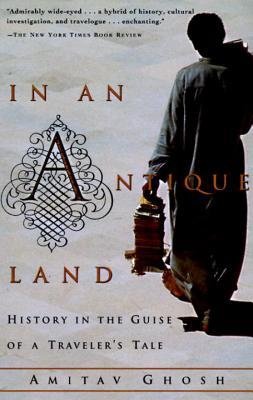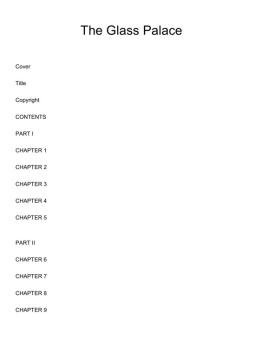Amitav Ghosh
Incendiary Circumstances: A Chronicle of the Turmoil of Our Times
To Barbara and Jeffrey J. W. Baker
For believing in this collection and bringing about its publication, I would like to thank Barney Karpfinger, my agent, and Janet Silver, publisher, of Houghton Mifflin. However, this volume would not have found its present form but for Meg Lemke, who edited and oversaw it, and even suggested the title. I owe her a great debt of gratitude.
My thanks are due also to the editors who first published these pieces: Leon Wiesletier at the New Republic, Katrina Vanden Heuvel at The Nation, N. Ram at the Hindu, Michael Neumann at Die Zeit, and most of all, Bill Buford, who as the editor of Granta and then as the fiction editor of The New Yorker was responsible for seeing many of these pieces into print.
My wife, Deborah Baker, assisted at the birth of many of these essays, and my gratitude to her, is, as always, beyond measure. I am grateful also to my children, Lila and Nayan, not least for providing me with the hours of wakefulness in which many of these pieces were written. Finally, I am glad to be afforded this opportunity to thank Barbara and Jeffrey Baker, not just for being the most welcoming of in-laws, but also for personifying the openness and generosity of America at its best.
Although these essays were written over a period of twenty years, some issues, themes, and concerns echo through all of them. The most important of these is stated, if only obliquely, in the passage from which the collection takes its title: "The deadly logic of terrorism is precisely to invite repression: it is thus that it brings into being the social gulf on which its existence is predicated. To write carelessly can all too easily add to the problem by appearing to endorse either terrorism or violent repression. In such incendiary circumstances words can cost lives, and it is only appropriate that those who deal in them should pay scrupulous attention to what they say."
These words were written not today or yesterday but ten years ago, as a meditation on an event that had occurred even earlier, in 1984: they are from "The Ghosts of Mrs. Gandhi," which was published in The New Yorker in 1995. But the passage owes its origins to a Gandhi other than that of the title: the Mahatma, who was for my generation of Indians what Freud had once been to Central Europeans that is to say, a ghost who was proof against all attempts at exorcism. His ideas had to be contended with, precisely because they were so strangely at variance with the disorder and violence of the world we lived in. For me, the aspect of Gandhi's thought that has been most productive perhaps is his insistence on the identity of means and ends. There is no such thing, Gandhi tells us, as a means to an end: means are ends.
Andr Breton once wrote that a ghost is "the finite representation of a torment." It is in this sense that Gandhi's ideas shaped the question that haunts these essays: is it possible to write about situations of violence without allowing your work to become complicit with the subject?
No doubt the reason that this question had a special urgency for me was because the "incendiary circumstances" of the title have been a part of the background of my everyday life since my childhood. Until recently it was possible to believe that there was something unusual or exceptional about those circumstances that they were merely an aspect of what V. S. Naipaul has called "half-made worlds." But not the least of the many momentous changes that have followed upon the tragedy of September 11, 2001, is the realization that the half-made world has become, as I write elsewhere in this collection, "the diviner of the fully formed."
It affords me no satisfaction that the "incendiary circumstances" of these essays are no longer exceptional anywhere in the world. But their contemporary relevance lies, I hope, not merely in the circumstances they address but also in the renewed urgency of the question of means and ends. For if there is anything instructive in the present turmoil of the world, it is surely that few ideas are as dangerous as the belief that all possible means are permissible in the service of a desirable end.
AMITAV GHOSH
Brooklyn, New York
February 14, 2005
THE ANDAMAN AND NICOBAR ISLANDS are one of those quadrants of the globe where political and geological fault lines run on parallel courses. Politically the islands have been administered from the Indian mainland ever since their annexation by the British; today they are Indian "Union Territories," ruled directly by New Delhi. But geologically the chain stands just beyond the edge of the Indian tectonic plate. Stretching through 435 miles of the Bay of Bengal, the islands are held aloft by a range of undersea mountains that stand guard over the abyssal deep of the Sunda Trench. Of the 572 islands, only 36 are inhabited: the Andamans is the name given to the northern part of the archipelago, while the Nicobars lie to the south. At their uppermost point, the Andamans are just a few dozen miles from Burma's Coco Islands, infamous for their prisons, while the southernmost edge of the Nicobars is only 125 miles from the ever-restless region of Aceh. This part of the chain is so positioned that the tsunami of December 26, 2004, hit it just minutes after it hit the coastline of northern Sumatra.
Despite the hundreds of miles of water that separate the Andamans from the Indian mainland, many of the relief camps in Port Blair, the islands' capital city, have the appearance of miniaturized portraits of the nation. Only a small percentage of their inmates are indigenous to the islands; the others are settlers from different parts of the mainland: Bengal, Orissa, Punjab, Andhra Pradesh, and Uttar Pradesh. If this comes as a surprise, it is because the identity of the islands and indeed the alibi for the present form of their rule lies in an administrative conception of the "primitive" that dates back to the British Raj. The idea that these islands are somehow synonymous with backwardness is energetically promoted in today's Port Blair. Hoardings depicting naked "primitives" line the streets, and I heard of a sign that instructs onlookers to "Love Your Primitive Tribe." In most parts of the mainland, these images would long since have been defaced or torn down, for the sheer offensiveness of their depictions; not so on these islands, which are more a projection of India than a part of its body politic. As with many colonies, they represent a distended and compressed version of the mother country, in its weaknesses and strengths, its aspirations and failings. Over the past two weeks, both the fault lines that underlie the islands seem suddenly to have been set in motion: it is as if the hurried history of an emergent nation had collided here with the deep time of geology.
The mainland settlers in the camps are almost unanimous in describing themselves as having come to the islands in search of land and opportunity. Listening to their stories, it is easy to believe that most of them found what they were looking for: here, in this far-flung chain of islands, tens of thousands of settlers were able to make their way out of poverty, into the ranks of the country's expanding middle class. But on the morning of December 26, this hard-won betterment became a potent source of vulnerability, for to be middle-class, in India or anywhere else, is to be kept afloat on a life raft of paper: identity cards, licenses, ration cards, school certificates, checkbooks, certificates of life insurance, and receipts for fixed deposits. It was the particular nature of this disaster that it targeted not just the physical being of the victims but also the proof of the survivors' identities. An earthquake would have left remnants to rummage through; floods and hurricanes would have allowed time for survivors to safeguard their essential documents on their persons. The tsunami, in the suddenness of its onslaught, allowed for no preparations. Not only did it destroy the survivors' homes and decimate their families; it also robbed them of all the evidentiary traces of their place in the world.











